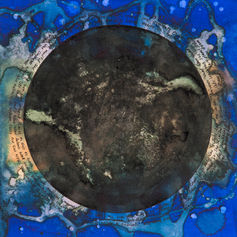

Fugitive Dust
M . Pravat
Curated by Sabih Ahmed
March 6 - August 29, 2021
CURATORIAL NOTE
Fugitive Dust is M. Pravat’s latest solo-exhibition presented at Vida Heydari Contemporary. It brings together artworks and studies from Pravat’s practice spanning from 2016, a period when he transitioned from making paintings to unmaking them. Since then, his works have deployed a range of media that include brick, cement, dust, slate, wood, metal, ink and graphite, and techniques that include grinding, sandblasting, carving, flaming, washing and drying. The transition into these processes does not signify that he has left painting in favour of another medium. Rather, as an artist formally trained in and committed to painting, his work seems to have shifted towards an undoing of the very foundations of painting. Anyone familiar with the history of art is well-aware that this is not a novel or unique trajectory. What is compelling, however, is how he approaches this project.
Pravat’s art practice draws on particular lived experiences of the built environment. Almost 15 years ago he moved from Vadodara, where he received his Master’s Degree in Painting from the Maharaja Sayajirao University, to Delhi where he has been residing ever since. After his move to the national capital, his attention has been directed to formal (and informal) properties of architecture and the city-scape, particularly towards areas where construction projects operate on the blurry line between what is legally sanctioned and what is not. These are the areas where he spends most of his time and where his own studio is situated. Here, the ways by which infrastructures are claimed and inhabited operate through porous and precarious logics, often at odds with the rules or guidelines prescribed by masterplans and municipal authorities. This does not lend itself to the occasional romanticism evoked around informal inhabitations, but rather brings one up close to sites of immense tension between different economic realities and asymmetries of power that are at the foundation of cities such as Delhi. Pravat’s practice attempts to capture specific forms of materialisations that take place amidst such environments.
The paintings that Pravat made during his early years of moving to Delhi delved into opaque fantasies mapped onto blueprints and interior design magazine covers. Gradually, his work shifted to representing under-construction sites and what seemed like abandoned incomplete buildings. There was always a simultaneous preoccupation with zoomed-out cityscapes and zoomed-in interior spaces captured through painterly distortions of maps and space studies in his work. Architectural space, enclosures, material densities, opacities and transparencies, circulations and flows, accumulations and dispersals, and the wear and tear of things have been recurring motifs in Pravat’s work. According to him, his practice emerged out of the perpetual state of under-construction that surrounded him.
In 2012, Pravat co-founded the Layout Collective comprising of Delhi based artist Susanta Mondal, Zurich based artist Navid Tschopp, and now Kolkata based architect S. Boka. Together they made a series of site-specific architectural interventions between 2012 and 2017 beginning in Pravat’s own studio in Neb Sarai, Delhi, going on to make further interventions in Kochi during the Kochi-Muziris Biennale, in the Kiran Nadar Museum of Art, in the Sarai Reader 09 exhibition and at the Jawaharlal Nehru University, in Delhi. These
‘location-based constructions’ by the Layout Collective worked like architectural growths within existing built spaces of the studio, the museum, the university and the ground. They were gestures of architectural disruption within institutional structures. In Pravat’s painterly practice, one can say that this figuratively broke the fourth wall.
Since 2016, as evidenced in the works presented in Fugitive Dust, a breakdown of the picture plane occurs in Pravat’s works where we are offered not so much an integrated image of the contemporary urban-scape but a disintegration of it as blue-prints, maps, architecture and geological land mass collapse into one another. The never-ending construction of his paintings now captures the unabating move ments between wear-and-tear, erosion, disintegration, demolition and reconstruction. The structures that are visible in his new works are made out of bricks and rubble that are further broken down. His studio is a site for multiple forms of material accumulations where the creation of these artworks mobilise a team of people who bring their knowledge from construction sites. Dust becomes an ally and a medium in his studio during the slow process of breaking down and building up his artworks.
According to Pravat, “the dust that rises from construction sites and demolition drives never settles.” We often wait for dust to settle, but dust keeps rising. It knows no borders. It is terrestrial, yet it is also extra-terrestrial. It is material, yet it is also atmospheric. Dust refuses to go away, it is displaced from one location to another, from one epoch to another and from one form to another. Urban environments are steeped in dust, some cities more than others and oftentimes as a peril when measured along with particulate matter and pollutants in the air. If places were seen through a refractive index of dust, we would see enormous migratory movements of materials and bodies that we are in the midst of. Dust is a reminder of those movements that are in essence geopolitical. In Pravat’s work, we observe a transitory crystallisation of these multiple states and movements. Fugitive Dust presents a condensed encounter with the material flux of contemporary reality through his practice.
- Sabih Ahmed
Installation Views








Selected Artworks






